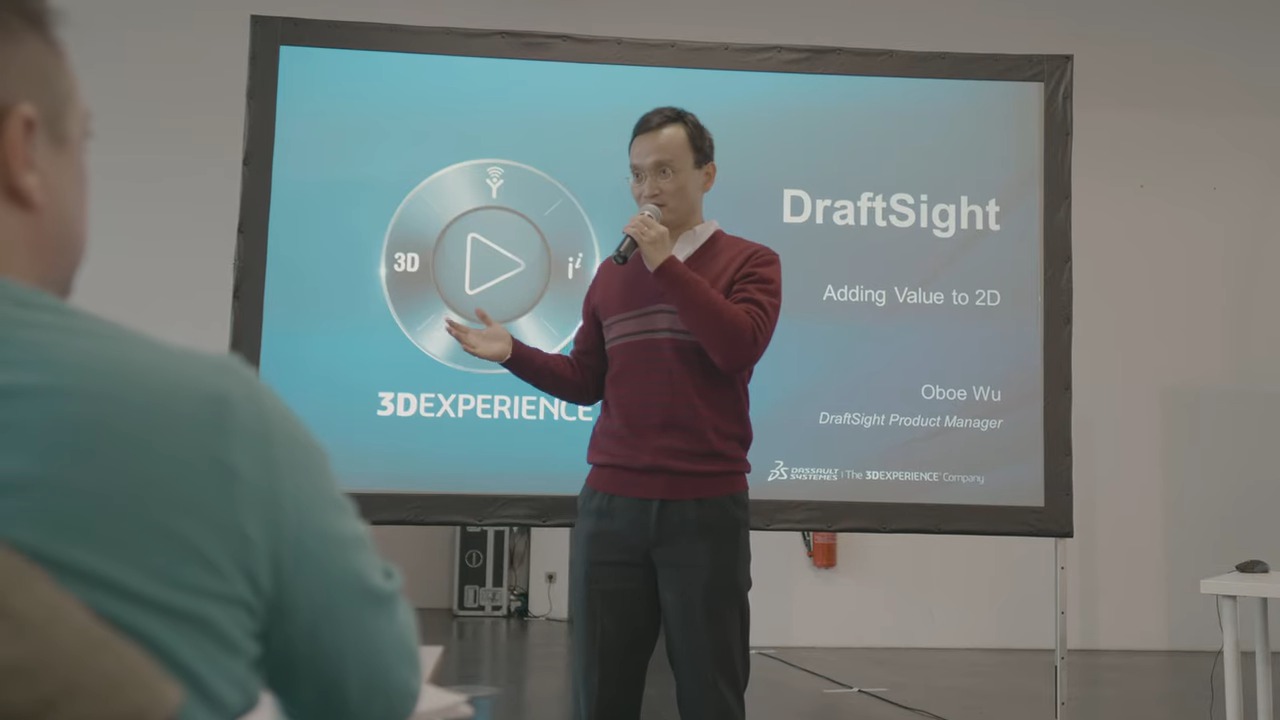Graebert to CAD Vendors: We Can Take You to the Cloud

Oboe Wu of Dassault Systemès tells attendees at the 2019 Graebert Annual Meeting how DraftSight complements SolidWorks in the manufacturing workflow. DraftSight uses technology from Graebert. Image courtesy of Graebert.
Latest News
December 5, 2019
Big news recently rippled through the CAD industry when PTC announced it was buying Onshape, the cloud-based mechanical design system (see “PTC Snatches Up Cloud CAD Pioneer Onshape”). PTC is not the only company who sees its future in the cloud. At the recent Graebert Annual Conference, Graebert presented its expanded vision for the cloud-based CAD technology it already sells as an OEM to several vendors including Onshape. Graebert used the Berlin conference to encourage CAD vendors to leverage its years of experience to create their own Cloud tools.
“We are not shy to say that Graebert’s ARES Kudo technology is years ahead of any competition,” says Wilfried Graebert, CEO and founder of Graebert GmbH. “Graebert took a head start in this technology by investing very early and attracting early partners such as Onshape.”
Graebert has been shipping cloud-active CAD for more than a year as part of its ARES series of CAD products. Now Graebert is sharing the results of its years of work with both end users and other vendors who wish to jumpstart their cloud/CAD development.
The larger world of IT has already significantly invested in the SaaS model (Software as a Service), but with few exceptions the engineering software industry has been lagging behind. According to an IDC survey quoted by Graebert, 72% of IT managers give preference to cloud-based (SaaS) solutions. A report from Zuora called the Subscription Economy Index (also quoted by Graebert) indicates that SaaS companies have been growing three times faster in sales than the non-SaaS software companies in the S&P 500 index.
“The CAD industry is facing the challenge to start immediately investing in Cloud without neglecting their existing on-premises solutions,” says Cedric Desbordes, director of marketing and business development for Graebert. “The SaaS transformation will inevitably take several years, most likely more than 10 years.”
At the annual meeting, Graebert shared with current and potential OEM clients how the existing Graebert line — the ARES Trinity of interconnected desktop, mobile, and browser CAD tools — already use Cloud technology to benefit from file synchronization and commenting tools. New markup features introduced at the conference extend annotation by making it easier for non-CAD users to collaborate without prior CAD experience.
ARES Kudo is the browser (Cloud) version of Graebert’s CAD line; it includes a C++ API that allows developers to use the same core code for both desktop and Cloud. The company also launched CLOUDify Pack for ARES Commander OEM. (ARES Commander is the desktop version of Graebert’s “Trinity of CAD.”) This optional development kit enables software vendors or motivated end users to add Cloud utility to their existing on-premise solutions. Features include:
- A Cloud Storage Palette which works with leading commercial solutions;
- A Commenting Palette to create discussion threads;
- A Share View-Only Links feature which generates a URL from the Cloud Storage Palette to share live updates of drawings.
Graebert says this combination of drawing access and commenting options allows both CAD professionals to edit and annotate drawings and non-CAD users to review and comment (including voice memos and photos) without the ability to modify geometry, all in the same workflow.
DWG in a Model World
Graebert is a small company, yet has become the second-largest CAD company by seats of its technology in use. This anomaly exists because Graebert is primarily a developer for other CAD vendors, including Dassault Systemès, Corel Corporation, Onshape (now PTC), Esri, and a variety of regional CAD vendors around the globe. Dassault Systemès has been a Graebert client for 10 years, and recently signed a new long-term deal.
“The future of design is integration,” notes Oboe Wu, DraftSight product manager for Dassault. The company is best known for SolidWorks and Catia, yet DraftSight has almost as many users as both 3D products combined.
Wu cited a recent study on model-based manufacturing which claims a model-based manufacturing design workflow is must faster than a strictly drawings-based workflow. However, two challenges remain. First, there is still the need to pull drawings from the model, and second, there are still 2 billion legacy files in DWG that often need to be consulted and the data integrated into new models.
The latest edition of DraftSight incorporates new features to integrate DWG drawings with SolidWorks models, including visualization and augmented reality views of product views within DraftSight. The new version also allows someone sketching a new part in 2D to extend it into 3D for handoff to SolidWorks.
Onshape added Graebert’s cloud-based 2D drafting technology based on continued customer request for sketching tools. Today Onshape uses Graebert’s Kudo Cloud-based drafting technology to offer drawing capabilities inside the Cloud-based modeler. “Onshape’s largest customer uses Kudo inside Onshape, and they also buy more Kudo,” notes Wilfried Graebert. “So this means we are the leader in Cloud CAD.”
To put a point of emphasis on the leadership claim, Graebert started the conference by announcing the publication of a white paper claiming Graebert ARES Kudo significantly outperforms Autodesk AutoCAD Web in head-to-head independent testing. The white paper, “Comparing Cloud-based CAD Systems from Autodesk and Graebert,” is written by well-known CAD expert Ralph Grabowski. The paper described the results of testing and details the two products feature by feature.
Both products are designed to be “use-anywhere” products, capable of opening and editing DWG-based drawings or starting new drawings on any device with a supported browser. Few other CAD vendors have web-based versions of their products, and most are view-only.
More Graebert Coverage
Subscribe to our FREE magazine, FREE email newsletters or both!
Latest News
About the Author
Randall S. Newton is principal analyst at Consilia Vektor, covering engineering technology. He has been part of the computer graphics industry in a variety of roles since 1985.
Follow DE





